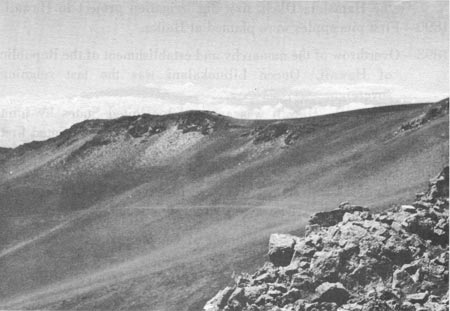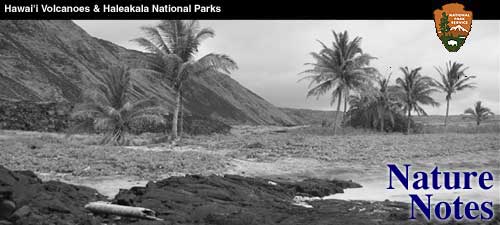| 500 A. D., ca.— | Hawaii discovered by
Hawaii-loa, Polynesian fisherman-navigator who, tradition says, came
from Kahiki (Tahiti?), an island to the south. He made several round
trips, bringing with him a large company of retainers. |
| 1100 ca.— | After a wave of navigation,
intercourse with Tahiti ended. |
| 1300 ca.— | According to an ancient
chant, mele, Kalaunuiohua, moi of Hawaii, conquered Maui.
Moi, in 19th century Hawaiian, signifies the supreme ruler or
head chief, now usually termed king. |
| 1500— | Piilani, king of Maui. He was
succeeded by Lonoapii who in turn was overthrown by his brother
Kihapiilani and his brother-in-law, King Umi of the Big Island. Bloody
battles stretched from Kauiki to the sands of Waihee. |
| 1555— | Possible discovery of Hawaii by
Juan Gaetano, Spanish navigator. He prepared a manuscript chart now in
the Spanish archives which contains a group of islands in the latitude
of Hawaii but whose longitude is 10 degrees too far to the east. What
corresponds to Maui is called La Desgradiada, the unfortunate.
The largest, most southerly island, which should be the present Hawaii
is labelled La Mesa, the table. Three other islands, appearing to
be Kahoolawe, Lanai, and Molokai, are called Los Monjes, the
monks. |
| 1736— | King Kekaulike died and was
succeeded by Kamehamehanui. |
| 1737— | Alapainui, moi of Hawaii,
invaded Maui via Kaupo. He took with him two young princely
half-brothers, Kalaniopuu and Keoua. Keoua was father of Kamehameha I.
Since Alapainui found his adversary, Kekaulike, dead, he made peace with
the nephew, Kamehamehanui. The two joined forces to repel the invader,
Kapiiohokalani of Oahu, in bloody, obstinate battles that ended in the
rout of the Oahu army at Kawela, Molokai. |
| 1738— | At Keawawa, West Maui,
Alapanainui and Kamehamehanui decisively defeated Kauhi, the latter's
brother and usurper of power. |
| 1750 ca.— | The calculated date of the
most recent activity of Haleakala, the Keoneoio flow above La Perouse
Bay. The flow originated at Kaluaolapa at an elevation of 575 feet, and
from vents one mile further northeast at an elevation of 1,550 feet. The
method of dating is interesting. In 1841, Rev. Edward Bailey of Wailuku
inquired about the eruption and was informed by Hawaiians that it
happened at the time of their grandfathers. In 1906, Lorrin A. Thurston
was told by a Chinese-Hawaiian cowboy, Charles Ako, that his
father-in-law's grandfather at the time of the event was just old enough
to carry "two" coconuts 4 or 5 miles from the sea to the upper road at
an elevation of 2,000 feet. Since Hawaiians counted coconuts by fours,
"two" probably refers to a total of eight nuts. Mr. Bailey was told that
a woman and child were trapped by the flow but escaped after it cooled.
By 1922, 80 years later, this tale had grown into a neo-myth about a
husband and wife with their two children. The mother and her young
daughter fled mauka, but were seized by Pele, and turned into the
two lava columns that stand beside the vent at Kaluaolapa. The father
and son, plunged into the sea and started swimming toward Kahoolawe.
Pele cast rocks after them and turned the two to stone. The two rocks, a
big and a little one, can be seen today rising out of the sea several
hundred feet out from shore as proof of the tale. Mr. Thurston's
estimate of the date of the eruption is 1750 while J. F. G. Stokes,
Hawaiian ethnologist, favors a later date, possibly 1770. |
| 1754— | Kalaniopuu, warlike king of
Hawaii, captured the fortress Kauiki and held it successfully for more
than 20 years. |
| 1765— | Kamehamehanui died and was
succeeded by his brother, Kahekili. |
| 1768— | Queen Kaahumanu was born at
Kauiki. She became the favorite wife of Kamehameha I. |
| 1775— | Kalaniopuu was defeated by
Kahekili at Kaupo. |
| 1776— | Kalaniopuu invaded Maui at
Maalaea; his army was annihilated on the sand hills near
Wailuku. |
| 1777— | Kalaniopuu took Lanai but again
was repelled when he tried to invade Maui, |
| 1778, November 26— | Captain James Cook,
Royal British Navy, discovered Maui. |
| 1781— | Kahekili reconquered East Maui.
He recaptured the fort at Kauiki by cutting off the water supply. To
show contempt, he baked the bodies of the defenders in earth
ovens. |
| 1786— | Kamehameha I sent an expedition
to recapture East Maui. It was defeated at Kipahulu by Kalanikapule, the
son of King Kahekili. |
| 1786, May 28— | La Perouse visited Maui
and camped on Keoneoio lava flow. |
| 1790— | Olowalu massacre. The snow,
Eleanor, under Captain Simon Metcalf, treacherously opened fire
on native boats following a truce made after one white sailor had been
murdered. More than a hundred natives were slaughtered. |
| 1790— | Conquest of Maui by Kamehameha I
after landing at Hana. He decisively defeated Kalanikapule, in the
Battle of Iao Valley or Kepaniwai. |
| 1793— | Vancouver visited Maui on his
second expedition. He tried to bring about an end to the wars and to
establish a lasting peace between Maui and Hawaii. |
| 1795— | Maui was subdued by Kamehameha I
without a battle. |
| 1819— | Kamehameha I, king of all
Hawaii, died. Abolition of the kapu system by Kamehameha II,
incited by his guardian, Queen Kaahumanu. |
| 1823— | The Christian mission at Lahaina
was founded by Rev. William Richards and A. S. Stewart. On September 16,
Queen Keopuolani, a wife of Kamehameha I and a devout Christian, died at
Lahaina. She was buried with services by Rev. William Ellis. |
| 1824— | At Lahaina, Queen Regent
Kaahumanu orally proclaimed a law forbidding desecration of the Sabbath,
fighting, murder, and theft. |
| 1825— | The English frigate The
Blonde anchored off Lahaina with the bodies of King Liholiho
(Kamehameha II) and his queen, Kamamalu. They had died from measles
while on a visit to London. |
| 1825— | The crew from the Whaler
Daniel attempted to demolish the home of Rev. Richards,
Lahaina. |
|

Sliding Sands Trail.
|
| 1826— | Mosquitoes from Mexico were
introduced at Lahaina by the SS Wellington. |
| 1827— | The Whaler John Palmer
fired on the home of Rev. Richards. |
| 1829— | Ascent of Haleakala by a
missionary party. |
| 1834— | First Hawaiian newspaper Lama
Hawaii was published at Lahainaluna Mission School. |
| 1839— | An Hawaiian "Bill of Rights" was
signed at Lahaina by Kamehameha III. It afforded protection to all
people and their property while they conformed to the laws of the
kingdom. |
| 1841— | Haleakala Crater was visited by
Pickering and Breckenridge of the United States Exploring Expedition
under Captain John Wilkes, U. S. Navy. |
| 1841-1849— | Peak of whaling industry in
Hawaii, Lahaina was visited by 596 whalers in 1846. |
| 1850— | David Malo, Hawaiian antiquarian
and teacher at Lahainaluna School, Lahaina, conducted Rev. William P.
Alexander and Curtis Lyons from Kaupo through Haleakala Crater, to
Makawao, "a trip never before undertaken by white men." |
| 1876— | S. F. Alexander and H. P.
Baldwin started construction of the Hamakua Ditch, first big irrigation
project in Hawaii. |
| 1890— | First pineapples were planted at
Haiku. |
| 1893— | Overthrow of the monarchy and
establishment of the Republic of Hawaii, Queen Liliuokalani was the last
reigning sovereign. |
| 1898, August 12— | Hawaii was annexed to
United States by joint legislation of Congress. President Dole was
appointed first governor. |
| 1916— | Hawaii National Park was
established by Act of Congress on August 1 with Haleakala Crater forming
the Section on Maui. |
| 1921— | Hawaii National Park was
formally opened. |
| 1929, November 11— | Establishment of
commercial air service between the islands. |
| 1930— | First permanent park position
(ranger) was established to give continuous service at
Haleakala. |
| 1931— | First permanent park naturalist
was appointed for Hawaii National Park, although temporary, summer
interpretive services were started in the late twenties by the
employment of Otto Degener, formerly botanist at the University of
Hawaii. Dr. Degener, presently writing Book 6 of his "Flora
Hawaiiensis," kindly supplied many of the scientific plant names for
this guide. |
| 1935-February 23— | Dedication
ceremonies of Haleakala Road in Hawaii National Park. |
| 1937— | Kapalaoa, Paliku, and Holua
cabins were constructed. |
| 1941— | Haleakala closed to travel for
military reasons. |
| 1952-3— | Present exhibits were
installed in Summit Observation Station. |
| 1958— | Permanent naturalist position
established for Haleakala. |
| 1959— | Hawaii becomes the 50th state in
the Union. |

